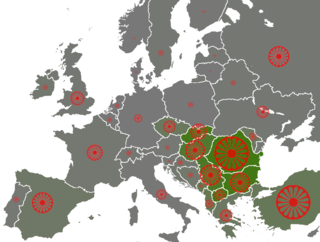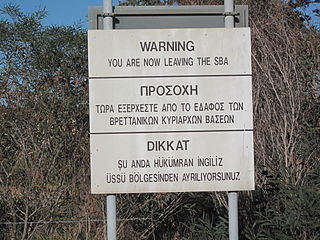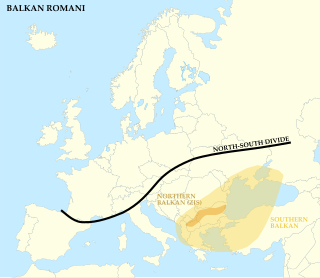
The Romani, also spelled Romany or Rromani and colloquially known as the Roma, are an ethnic group of Indo-Aryan origin who traditionally lived a nomadic, itinerant lifestyle. Linguistic and genetic evidence suggests that the Romani originated in the Indian subcontinent, in particular the region of present-day Rajasthan. Their subsequent westward migration, possibly in waves, is now believed by historians to have occurred around 1000 CE. Their original name is from the Sanskrit word डोम, doma and means a member of the Dom caste of travelling musicians and dancers. The Roma population moved west into the Persian Ghaznavid Empire and later into the Byzantine Empire. The Roma are thought to have arrived in Europe around the 13th to 14th century. Although they are widely dispersed, their most concentrated populations are located in Bulgaria, Hungary, Romania, Spain, and Turkey.

Romani music is the music of the Romani people who have their origins in northern India but today live mostly in Europe.
Gurbeti are a sub-group of the Romani people living in Cyprus and North Cyprus, Turkey, Crimea, Albania, Serbia and the former Yugoslavia whose members are Eastern Orthodox and predominantly Muslim Roma. The Gurbeti make up approximately two thirds of the population of Roma in Macva, many of whom work in agriculture. In Kosovo, other Romani groups viewed the Gurbeti negatively.

The Romani people are a distinct ethnic and cultural group of peoples living all across the globe, who share a family of languages and sometimes a traditional nomadic mode of life. Though their exact origins are unclear, central India is a notable point of origin. Their language shares a common origin with, and is similar to, modern-day Gujarati and Rajasthani, borrowing loan words from other languages as they migrated from India. In Europe, even though their culture has been victimized by other cultures, they have still found a way to maintain their heritage and society. Indian elements in Romani culture are almost non-existent, with the exception of their language. Romani culture focuses heavily on family. The Roma traditionally live according to relatively strict moral codes. The ethnic culture of the Romani people who live in central, eastern and southeastern European countries developed through a long, complex process of continuous active interaction with the culture of their surrounding European population.
Minorities in Greece are small in size compared to Balkan regional standards, and the country is largely ethnically homogeneous. This is mainly due to the population exchanges between Greece and neighboring Turkey and Bulgaria, which removed most Muslims and those Christian Slavs who did not identify as Greeks from Greek territory. The treaty also provided for the resettlement of ethnic Greeks from those countries, later to be followed by refugees. There is no official information for the size of the ethnic, linguistic and religious minorities because asking the population questions pertaining to the topic have been abolished since 1951.

Romani people in Bulgaria constitute Europe's densest Roma minority. The Romani people in Bulgaria may speak Bulgarian, Turkish or Romani, depending on the region.

The official language of Greece is Greek, spoken by 99% of the population. In addition, a number of non-official, minority languages and some Greek dialects are spoken as well. The most common foreign languages learned by Greeks are English, German, French and Italian.

The Romani people have several distinct populations, the largest being the Roma and the Calé, who reached Anatolia and the Balkans in the early 12th century, from a migration out of the Indian subcontinent beginning about 1st century – 2nd century AD. They settled in the areas of present-day Turkey, Greece, Serbia, Romania, Croatia, Moldova, Bulgaria, North Macedonia, Hungary, Albania, Kosovo, Bosnia and Herzegovina, Czech Republic, Slovenia and Slovakia, by order of volume, and Spain. From the Balkans, they migrated throughout Europe and, in the nineteenth and later centuries, to the Americas. The Roma population in the United States is estimated at more than one million.

The official language of North Macedonia is Macedonian, while Albanian has co-official status. Macedonian is spoken by roughly two-thirds of the population natively, and as a second language by much of the rest of the population. Albanian is the largest minority language. There are a further five national minority languages: Turkish, Romani, Serbian, Bosnian, and Aromanian. The Macedonian Sign Language is the country's official sign language.
The Romani people of Greece, or Romá, are called Tsinganoi, Athinganoi (Αθίγγανοι), or the more derogatory term Gyftoi. On 8 April 2019, the Greek government stated that the number of Greek Roma citizens in Greece is around 110,000. Other estimates have placed the number of Romani people resident in Greece as high as 350,000.
Its members are referred to as Turkish Gypsy, Türk Çingeneler, Turski Tsigani, Turkogifti (τουρκο-γύφτοι), Țigani turci, Török Cigányok, Turci Cigani. Through self-Turkification and Assimilation in the Turkish culture over centuries, this Muslim Roma have adopted the Turkish language and lost Rumelian Romani language, in order to establish a Turkish Identity to become more recognized by the Host population and deny their Romani background to show their Turkishness. At Population Census they declared themself as Turks instead as Roma and said How happy is the one who says I am a Turk, however, Turks consider them as fake-Turks, and Christian Romani do not consider them as part of the Romani society. They are Cultural Muslims who adopted Sunni Islam of Hanafi madhab and Religious male circumcision at the time of the Anatolian Seljuk Sultanate and Ottoman Empire. Their legendary leader was Mansur ibn Yakub Han, called Çingene Han. He built his karavansaray in Malatya in 1224. Today it can still be seen as a ruin. Mansur bin Yakup Han is buried in the Ulu Mosque in Malatya.

The official languages of the Republic of Cyprus are Greek and Turkish. The everyday spoken language (vernacular) of Greek Cypriots is Cypriot Greek, and that of Turkish Cypriots is Cypriot Turkish. For official purposes, the standard languages are used.

Muslim Romani people are people who are ethnically Roma and profess Islam. There are many different Roma groups and subgroups that predominantly practice Islam, as well as individual Romani people from other subethnic groups who have accepted Islam. Xoraxane Roma in Balkan Romani language, are non-Vlax Romani people, who adopted Sunni Islam of the Hanafi madhhab at the time of the Ottoman Empire. Some of them are Derviş of Sufism belief, and the biggest Tariqa of Jerrahi is located at the largest Arlije and Gurbeti Muslim Roma settlement in Europe in Šuto Orizari, locally called Shutka in North Macedonia have their own Romani Imam and the Muslim Roma in Šuto Orizari use the Quran in Balkan Romani language. Many Romanlar in Turkey, are members of the Hindiler Tekkesi a Qadiriyya-Tariqa, founded in 1738 by the Indian Muslim Sheykh Seyfullah Efendi El Hindi in Selamsız. Roma Muslims in Turkey and the Balkans are mostly cultural Muslims or nominal Muslims.
The Romani people in Turkey or Turks of Romani background are Turkish citizens and the biggest subgroup of the Turkish Roma. They are Sunni Muslims mostly of Sufi orientation, who speak Turkish as their first language, in their own accent, and have adopted Turkish culture. Many have denied their Romani background over the centuries in order to establish a Turkish identity, to become more accepted by the host population. They identify themselves as Turks of Oghuz ancestry. More specifically, some have claimed to be members of the Yörüks, Amuca, Gajal or Tahtacı.

Ethnic groups in the Middle East, in the 'transcontinental' region which is commonly a geopolitical term designating the intercontinental region comprising West Asia without the South Caucasus, and also comprising Egypt in North Africa. The region has historically been a crossroad of different cultures and languages. Since the 1960s, the changes in political and economic factors have significantly altered the ethnic composition of groups in the region. While some ethnic groups have been present in the region for millennia, others have arrived fairly recently through immigration. The largest socioethnic groups in the region are Arabs, Turks, Persians, Kurds, and Azerbaijanis but there are dozens of other ethnic groups that have hundreds of thousands, and sometimes millions of members.

Balkan Roma, Balkaniko Romanes, or Balkan Gypsy is a specific non-Vlax dialect of the Romani language, spoken by groups within the Balkans, which include countries such as Albania, Bosnia-Herzegovina, Bulgaria, Greece, Kosovo, North Macedonia, Serbia, Slovenia, Turkey etc. The Balkan Romani language is typically an oral language.

The Turks in Europe refers to Turkic peoples living in Europe, particularly those of Turkish origin.
Sepečides Romani, also known as Sevlengere Roma, is the Romani dialect of the traditionally basketweaving Roma originally from Thessaloniki. Their ancestors lived there as nomads during the Ottoman Empire until the population exchange between Greece and Turkey. The Sepečides dialect is considered to be non-Vlax. It belongs to the Southern Balkan group of Romani dialects, although the RomArchive claims the language is practically extinct.

Romani people in Germany are estimated to around 170,000-300,000, constituting around 0.2-0.4% of the population. One-third of Germany Romani belong to the Sinti group. Most speak German or Sinte Romani.
Albania houses a large population of Romani, who are part of the larger Romani diaspora.












